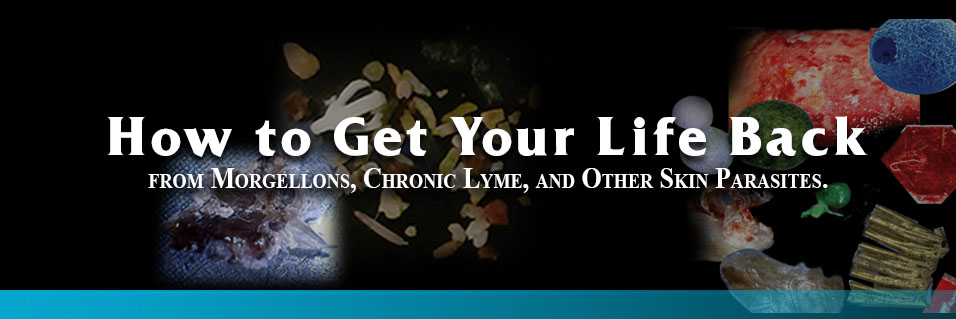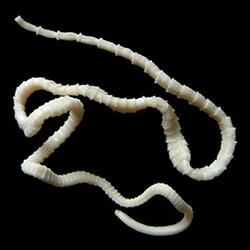

|
 |
The Different Types of Parasites That Affect Morgellons Disease 1/5/19 |
Morgellons is a disease that is unique to each individual. On one hand, it is a disease associated with a form of Lyme disease as reported in a previous blog post, Lyme Spirochetes Found in Morgellons Sufferers11/29/18. But talk to most any Morgellons sufferer and you'll find a parasitic component. And there are the macro parasites such as bed bugs and other creatures and the micro parasites which this update is about. • Three main classes. Three main categories of parasites may cause disease in humans:
> Most protozoa and helminths don’t cause disease and result in very mild illness. > Some, however, can cause severe disease in humans. • Faecal-oral transmission > Wikki states specifics on transmission and guidelines regarding sanitation. Gastrointestinal symptoms like diarrhea and constipation result. • At what point does parasitism become a health challenge?
• Protozoa Are single celled organisms that multiply within the body. > For example the protozoa giardia has a two stage life cycle. 1st stage the parasite swims around and consumes nutrients from the small intestine. 2nd stage it develops into a non-moving cyst or polyps. • Herein lies the challenge.
> Ingesting contaminated food or water results in transmission. > Close human contact and unsanitary living conditions will promote transmission. • Giardia infections are most common causes of waterborne disease in the United States. > Symptoms outlined as per Mayo Clinic > Plasmodium develops in mosquitoes. Infected mosquitoes transmit the parasite to humans when bitten. Plasmodium destroys red blood cells impacting organ function causing malaria.
> An estimated 819 million people worldwide are infected with roundworm, 464 million with whipworm and 438 million with hookworm. One main group of helminths are flatworms. Flatworms have soft flattened bodies. Their digestive tract has one opening for both the ingestion and removal of food. It is believed about 80% of flatworms are parasitic. > Tapeworms are a type of flatworm.
• Nematodes are another major group of helminths, commonly known as roundworm. > Nematodes are the most abundant multi-cellular animals on earth and are found in almost every environment. > They do have a digestive system that extends from the mouth to the anus, unlike flatworms. > It’s estimated that more than 50% of the world’s population are affected at some point during their life by nematodes. > The larvae or eggs of nematodes normally develop in soil and then transmitted to the humans by penetrating the skin. > Another nematode, the pinworm or threadworm bears a different life cycle to other nematodes. > Pinworm larvae are found from eggs on the skin near the anus or under the fingernails. > The main symptom of pinworm is itching around the anus and because they are under the fingernails are easily transmitted. • Ectoparasites are organisms like ticks, fleas, mites and lice that attach and burrow into the skin remaining for long periods in time. > Prime examples being scabies, a highly contagious skin disease marked by small raised red spots and itching. Transmission by skin to skin contact. > Head lice are wingless insects that breed and live in human hair. Blood suckers that feed from the scalp. • Parasites can lie dormant. > As per The Conversation Parasites can lie dormant for extended periods of time. Diagnosis of parasites hence can be challenging due to no symptoms or symptoms could be vague and non specific. Part of Richard's protocol is to deal with helminths (nematodes) with:
A parasite is an organism that lives inside or on an organism of another species (its host) and benefits by obtaining it’s nutrients at the expense of the host. • Three main classes of parasites that may cause disease in humans: 1) Protozoa (Generally speaking single-celled heterotrophic eukaryotes, which eat bacteria and other food sources) Protozoa and helminths mostly affect the gut, while ectoparasites include lice and mites that can live on and burrow into the skin, staying there for long periods of time.
> Most protozoa and helminths don’t cause disease and result in very mild illness. > Some, however, can cause severe disease in humans. • Faecal-oral transmission > Wikki states specifics on transmission and guidelines regarding sanitation. Gastrointestinal symptoms like diarrhea and constipation result. • At what point does parasitism become a health challenge? > Parasitic invasion of blood cells and organs will result in serious consequences. • Protozoa Are single celled organisms that multiply within the body. > For example the protozoa giardia has a two stage life cycle. 1st stage the parasite swims around and consumes nutrients from the small intestine. 2nd stage it develops into a non-moving cyst or polyps. • Herein lies the challenge.
> Ingesting contaminated food or water results in transmission. > Close human contact and unsanitary living conditions will promote transmission. • Giardia infections are most common causes of waterborne disease in the United States. > Symptoms outlined as per Mayo Clinic > Plasmodium develops in mosquitoes. Infected mosquitoes transmit the parasite to humans when bitten. Plasmodium destroys red blood cells impacting organ function causing malaria. • Helminthscommonly known as worms are large multi cellular organisms visible to the naked eye in adult stage. > As per Pharmacetical Journal they live either as parasites, or on their own free of a host, in aquatic and terrestrial environments. The most common worldwide are intestinal nematodes or soil-transmitted helminths and filarial worms, which cause lymphatic filariasis and onchocerciasis. > An estimated 819 million people worldwide are infected with roundworm, 464 million with whipworm and 438 million with hookworm. One main group of helminths are flatworms. Flatworms have soft flattened bodies. Their digestive tract has one opening for both the ingestion and removal of food. It is believed about 80% of flatworms are parasitic. > Tapeworms are a type of flatworm. > Infestation in humans comes from consuming tapeworm eggs. Transmission from occurs via the faecal-oral means. • Nematodes are another major group of helminths, commonly known as roundworm.
> They do have a digestive system that extends from the mouth to the anus, unlike flatworms. > It’s estimated that more than 50% of the world’s population are affected at some point during their life by nematodes. > The larvae or eggs of nematodes normally develop in soil and then transmitted to the humans by penetrating the skin. > Another nematode, the pinworm or threadworm bears a different life cycle to other nematodes. > Pinworm larvae are found from eggs on the skin near the anus or under the fingernails. > The main symptom of pinworm is itching around the anus and because they are under the fingernails are easily transmitted. • Ectoparasites are organisms like ticks, fleas, mites and lice that attach and burrow into the skin remaining for long periods in time. > Prime examples being scabies, a highly contagious skin disease marked by small raised red spots and itching. Transmission by skin to skin contact. > Head lice are wingless insects that breed and live in human hair. Blood suckers that feed from the scalp. • Parasites can lie dormant. > As per The Conversation Parasites can lie dormant for extended periods of time. Diagnosis of parasites hence can be challenging due to no symptoms or symptoms could be vague and non specific. Part of Richard's protocol is to deal with helminths (nematodes) with: Where does Morgellons fit in this minagary of parasites?
> One strange occasion every single itchy spot I had decades ago flared up, the exact same itchy sites came up and I began to feel things crawling on my head. It was a sudden thing. > One evening I taped newspaper around the circumference of my head forming an open funnel at the top of my head. I poured every essential oil I owned on my head through the opening at the top. I then closed the top of the newspaper. From 9.30 that evening till 3am the next morning I heard the critters coming out. Sounded like rain on a tin roof. > Shaking the newspaper out to see what was in there I saw tiny little glitter dust particles floating around, some were like mini drones from hell that had direction and purpose in their flight as they soared through the air. > The itchy bumps disappeared immediately and all went quiet on my head. Not long after that some more itchy sites suddenly came up. I tried the same thing and no rain on a tin roof results. After soaking in a bath together with vigorous scrubbing my scalp I saw the tiniest little dots appear in the bath. A macro lens showed winged creatures. > I sure know these winged insects grew wings because it was their time to leave. Why else would they have wings? Nature provides what is needed when it is needed. > These critters also create their own fungal tracks I was to discover. Bottom line if we get rid of the fungus we get rid of the critters. Seemingly these critters do not live in fungus, they are critters and fungus. They also spore and release biofilms. They are also burrowers and can go deep into the body I discovered. There is no limit to the depth they can go. More on this topic another time. > They cause ridges in the nails. Doing pedicures for senior citizens was an eye opener for me. They all have ridges in their nails like I developed after infecting my hands. Upon filing their nails I could see the same mini drones flying around as I have. Sometimes I got prickles firing in my direction when doing the pedicures, very subtle. Nothing that the normal Joe Soap would bat an eyelid to. I gave up that work immediately. > Seemingly these critters are not targeting the skin of these people as they are unaware. But rather these fungal critters are operating on a deeper level causing the host of diseases I saw in the elderly. With having Morgellons you get to understand and see things on a deeper level. As time is going by I see my skin is becoming firmer and wrinkles are going. It’s inspiring to know that through following the diet and keeping to the protocols as per Richards questionnaire that we will eventually get to the point of huge rewards. The greater the curse = the greater the blessings! It is seeing these results that keeps me strong and inspired. Keep at it, you to will begin to feel the same way! by Diane Shannon, South Africa
|

|